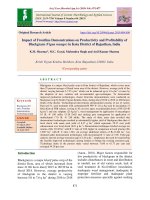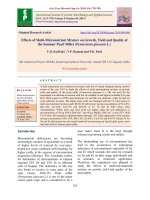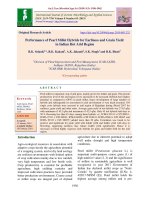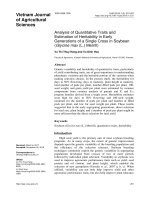Quantitative GXE interaction estimation in the germplasm of pearl millet [Pennisetum glaucum (L.) R. Br.] in the hot arid climate of Rajasthan
Bạn đang xem bản rút gọn của tài liệu. Xem và tải ngay bản đầy đủ của tài liệu tại đây (214.33 KB, 7 trang )
Int.J.Curr.Microbiol.App.Sci (2018) 7(10): 3152-3158
International Journal of Current Microbiology and Applied Sciences
ISSN: 2319-7706 Volume 7 Number 10 (2018)
Journal homepage:
Original Research Article
/>
Quantitative GXE Interaction Estimation in the Germplasm of Pearl Millet
[Pennisetum glaucum (L.) R. Br.] in the Hot Arid Climate of Rajasthan
Om Vir Singh, Kartar Singh and Neelam Shekhawat*
National Bureau of Plant Genetic Resources, Regional Station, Jodhpur, India
*Corresponding author
ABSTRACT
Keywords
Pearl millet, Hot arid climate,
Accession x Environment
interaction, Crossover and
non-crossover interaction,
Regression analysis
Article Info
Accepted:
24 September 2018
Available Online:
10 October 2018
Twenty nine accessions of pearl millet along with checks were evaluated in five seasons
i.e. Kharif of the year 2012, 2013, 2014, 2015 and 2016 for eight quantitative traits and
data were subjected to regression analysis and also the analysis to detect the presence of
crossover and non-crossover interactions. Three accessions IC 426855, IC 325181 and IC
139920 were identified to be promising using regression analysis, whereas five accessions
IC 325794, IC 426855, IC 369859, IC 329055 and IC 325181 against standard check RAJ.
171 were identified as potential ones by using crossover and non-crossover interactions
concept. Of these accessions IC 426855 and IC 325181 have been identified as high
yielding accessions having specific adaptability and responsiveness to specific
environment both by regression analysis and crossover and non-crossover interactions
concept.
Introduction
Productivity of pearl millet in the hot- arid
climate has always not been comparable to the
normal climatic conditions. Pearl millet is
cultivated during Summer and Kharif seasons
in India but in western Rajasthan pearl millet
is cultivated during kharif season only due to
limitations of the irrigation water. A plenty of
good hybrids and open pollinated varieties
have been developed by the public and private
sectors for cultivation in India but there are
only a few hybrids for the western Rajasthan
where annual rainfall is very limited (< 300
mm) and climate is very hot and dry. In some
areas specially in Barmer and Jaisalmer
districts of western Rajasthan still farmers are
growing their low yielding land races, which
are adapted to such type of climatic conditions
but productivity of these land races is very low
(< 100 Kg/ha). To enhance productivity and
production of pearl millet it is advocated that
breeders should look for environment specific
varieties/hybrids which are capable of giving
high yield. This becomes more important in
case of pearl millet to breed for their
responsiveness to specific environment as it is
grown in a wide range of climatic conditions.
Keeping in view the above, the present
investigation was carried out over five years
during Kharif season in the hot- arid climate
of Rajasthan to identify suitable accessions of
pearl millet using regression analysis
(Eberhart and Russell, 1966 and Perkins and
Jinks, 1968) and cross and non-crossover
interactions concept (Gail and Simon, 1985).
3152
Int.J.Curr.Microbiol.App.Sci (2018) 7(10): 3152-3158
Earlier information on this aspect in pearl
millet germplasm is not available.
Materials and Methods
Twenty nine diverse accessions collected in
different years from different place from
Rajasthan and adjoining states along with best
performing local checks i.e. RAJ 171 (OPV)
and two hybrids HHB 67 and RHB 173were
evaluated in a randomized block design with
three replications over five years in 2012,
2013, 2014, 2015 and 2016 during i.e. Kharif
seasons at Regional Station of National
Bureau of Plant Genetic Resources, Jodhpur.
Thus, evaluation was done broadly in five
environments. In each environment plots
consisted of four rows of 3 m length with row
to row and plant to plant distances of 45 and
15cm, respectively. Recommended doses of
P2O5 @30 kg /ha and N2@ 40 kg/ha were also
applied at the time of sowing and side dressing
at the seedling age of 25 days. Recommended
packages of practices were followed to raise
good crop. The data were recorded on five
randomly taken plants from middle rows of
each plot in each environment on seed
yield/plant (g), biological yield/plant (g),
harvest index (direct values were used for
statistical analysis), number of effective tillers
per plant, plant height, flag leaf area, ear head
length (cm) and days to 50% flowering and
data were analyzed separately for each
environment. Adjusted progeny means were
used for the combined analysis and for the
traits exhibiting the presence of g x e
interaction. Regression analysis and analysis
to detect the presence of crossover and noncrossover interactions were carried out as per
Eberhart and Russell (1966), Perkins and Jinks
(1968) and Gail and Simon (1985).
Results and Discussion
Analysis of variance revealed significant
differences among accessions for the eight
traits in all five years. The combined analysis
revealed the presence of g x e interaction for
seed yield/plant (g), biological yield/plant (g),
harvest index, number of effective tillers per
plant, plant height, flag leaf area, ear head
length (cm) and days to 50% flowering.
Regression analysis enables breeders to select
desirable accessions with respect to the
responsiveness and stability in different
environments. In the studied materials the
accessions IC 139920IC 325181 and IC
426855 had above average performance and
responsiveness with respect to seed yield/plant
using regression analysis (Table 1). Among
these high yielding accessions IC 139920 can
be designated as stable ones with average
responsiveness.
Though the accessions IC 325181 and IC
426855 are above average yielder and also
have shown above average responsiveness
coupled with instability. Accession IC 325181
and IC 426855 were highest yielder during
Kharif 2013 and Kharif 2015 respectively
followed by IC 139920 (Kharif, 2012) and
were significantly superior to the best check
RAJ 171.
The accession IC 325181 had above average
performance along with instability for seed
yield/plant (g), biological yield/plant (g),
harvest index, number of effective tillers per
plant, plant height, ear head length (cm) and
days to 50% flowering being the best
performance of this accession for these traits
again in Kharif 2013 and accession IC 426855
showed above average performance along
with instability for seed yield/plant (g),
biological yield/plant (g), harvest index, ear
head length (cm) and days to 50% flowering
for these traits again during Kharif 2015.
The regression technique describes the
response pattern of individual accession
without differentiating the kind of g x e
interaction involving change in magnitude of
3153
Int.J.Curr.Microbiol.App.Sci (2018) 7(10): 3152-3158
response or direction among the accessions
(Baker, 1988; and Virk and Mangat 19915).
Baker (1988) described a test, which was
initially proposed by Gail and Simon (1985)
and illustrated its application to test the kind
of interaction in crop plants.
The concept of crossover and non-crossover
interaction is important in decision making
relating to crop improvement strategies
(Baker, 1988), since the presence of crossover
interaction is substantial evidence in favour of
breeding for specific adaptation to certain
situations. Baker (1988) further suggested that
in the absence of crossover interaction there is
little substance for argument in the favour of
breeding
for
adaptation
to
specific
environment. The accessions exhibiting
crossover interaction against a standard
variety can be said to have specific
adaptability and can replace that standard
variety in the specific environments.
The existence of prior scientific basis to
explain crossover interaction is crucial (Peto,
1982). Thus, it is advantageous to define the
varietal combinations among which one has to
look for qualitative interaction in advance.
There will be enormous multiplicity of all
possible varietal pairs for detection of
crossover interaction if there is no prior basis
for comparison.
Such a practice will greatly increase the
experiment-wise error rate. In the present case
the new accessions were therefore, compared
with the best check RAJ. 171 for detection of
crossover interaction since the aim was to find
a suitable alternative to RAJ. 171.
The H (heterogeneity of response) and Q+ and
Q- (for the presence of crossover interaction)
against the standard variety RAJ. 171 were
estimated for all the 28 accessions for the
traits exhibiting the presence of g x e
interaction, i.e., seed yield/plant (g), biological
yield/plant (g), harvest index, number of
effective tillers per plant, plant height, flag
leaf area, ear head length (cm) and days to
50% flowering and their significance was
tested (Baker, 19884). The accession
exhibiting either significant H or Q+ and Qare given in Table 2. For seed yield/plant H
was significant for the 26accessions against
RAJ. 171. The presence of crossover
interaction was observed for 24 accessions
namely IC 285200, IC 325181, IC 323993, IC
325740, IC 325794, IC 370475, IC 369836, IC
369859, IC 329028, IC 329055, IC 329076,
IC420312, IC 420345, IC 373424, IC 373504,
IC 373564, IC 449485, IC 577599, IC 577625,
IC 577642, IC 426855, IC 426876, IC 426908
and IC 329909 against RAJ. 171.
The 22 accessions i.e. IC 145316, IC 285176,
IC 285200, IC 325181, IC 323993, IC 325740,
IC 325794, IC 325835, IC 333121, IC 369836,
IC 369859, IC 329028, IC 329055, IC420312,
IC 373504, IC 373564, IC 449485, IC 577599,
IC 577642, IC 426855, IC 426876 and IC
329909 exhibited the presence of crossover
interaction for biological yield/plant and
twenty nine accessions namely, IC 145316, IC
285176, IC 285200, IC 325181, IC 323993, IC
325740, IC 325794, IC 325835, IC 370475, IC
333121, IC 369836, IC 369859, IC 329028, IC
329055, IC 329076, IC420312, IC 420345, IC
373424, IC 373504, IC 373564, IC 449485, IC
577599, IC 577625, IC 577642, IC 426855, IC
426876, IC 426908 and IC 329909 exhibited
the presence of crossover g x e interaction for
harvest index.
The 23 accessions exhibited the presence of
crossover interaction for number of effective
tillers per plant for the accessions namely, IC
145316, IC 285200, IC 325181, IC 323993, IC
325794, IC 325835, IC 333121, IC 369836, IC
369859, IC 329028, IC 329055, IC 329076,
IC420312, IC 420345, IC 373424, IC 373564,
IC 449485, IC 577625, IC 577642, IC 426855,
IC 426876, IC 426908 and IC 329909.
3154
Int.J.Curr.Microbiol.App.Sci (2018) 7(10): 3152-3158
Table.1 Heterogeneity (H) test of response for the comparison of mean seed yield/plant (g)
against the standard variety RAJ. 171 along with Q+ and Q- values for crossover interaction and
adaptability parameters for the accessions
Accession
Adaptability Parameters
Against RAJ. 171
u+di
Bi ± SE
σ2di
H
Q+
Q-
IC 329028
11.43
-0.35* ± 0.25
0.09*
52.85#
80.45$
104.19
IC 139920
13.32
0.28 ± 0.19
0.02
94.11#
38.95
43.27
IC 285200
9.45
0.58* ± 0.32
0.32*
29.64#
101.86$
107.96
IC 323993
11.15
0.97* ± 0.43
0.48*
63.35#
93.55$
161.89
IC 325181
14.09
1.39* ± 0.67
0.60*
24.42#
141.83
91.50$
IC 325740
13.10
0.55* ± 0.43
0.33*
47.30#
167.74
131.26$
IC 325815
7.98
-0.24* ± 0.12
0.59*
102.87#
94.65
91.97$
IC 329055
13.48
0.11* ± 0.09
0.03
36.57#
45.76
62.53
IC 329076
12.21
0.97* ± 0.31
0.76*
178.89#
135.65$
95.84
IC 329909
10.07
0.60* ± 0.36
0.37*
53.16#
98.45
186.97$
IC 369859
12.98
-0.24* ± 0.08
0.05
44.34#
52.23
32.76
IC 370475
9.19
0.96* ± 0.49
0.34*
93.75#
169.59
109.81$
IC 373424
9.90
-0.88* ± 0.32
0.25*
134.35#
67.22
141.61$
IC 373504
12.52
-1.07* ± 0.52
0.44*
95.17#
118.59
92.43$
IC 373564
12.35
0.93* ± 0.29
0.22*
113.02#
109.72
97.67$
IC 420345
9.15
1.42 ± 0.37
0.61*
87.83#
85.94
127.94$
IC 426855
14.75
1.12* ± 0.34
0.48*
65.14#
132.61$
72.34
IC 426876
8.87
0.97* ± 0.21
0.53*
94.97#
82.89
204.11$
IC 525794
14.93
1.34* ± 0.42
0.06
49.28#
60.13
60.39
IC 577642
8.99
0.70* ± 0.23
0.32
128.46#
108.74$
92.65
Grand Mean9.08 ± 1.21
RAJ. 17111.43 ± 0.89
• Significant at P < 0.05; # H was significant against x2 0.05 at s-l df, where s is the number of environments. $
minimum of either Q+ or Q- was significant against "e" value given by Gail and Simon (1985).
3155
Int.J.Curr.Microbiol.App.Sci (2018) 7(10): 3152-3158
Table.2 Accessions exhibiting significant *, #H (heterogeneity of response), and Q+ and Qagainst standard variety RAJ. 171
Q+ and QIC 285200, IC 325181, IC 323993, IC 325740, IC
325794, IC 370475, IC 369836, IC 369859, IC 329028,
IC 329055, IC 329076, IC420312, IC 420345, IC
373424, IC 373504, IC 373564, IC 449485, IC 577599,
IC 577625, IC 577642, IC 426855, IC 426876, IC
426908, IC 329909 (24 accessions)
All
accessions
IC 145316, IC 285176, IC 285200, IC 325181, IC
Biological yield/ plant (g)
except IC 325835 323993, IC 325740, IC 325794, IC 325835, IC 333121,
and IC 329076
IC 369836, IC 369859, IC 329028, IC 329055,
IC420312, IC 373504, IC 373564, IC 449485, IC
577599, IC 577642, IC 426855, IC 426876, IC 329909
(22 accessions).
All
accessions IC 145316, IC 285176, IC 285200, IC 325181, IC
Harvest index
except IC 329028
323993, IC 325740, IC 325794, IC 325835, IC 370475,
IC 333121, IC 369836, IC 369859, IC 329028, IC
329055, IC 329076, IC420312, IC 420345, IC 373424,
IC 373504, IC 373564, IC 449485, IC 577599, IC
577625, IC 577642, IC 426855, IC 426876, IC 426908,
IC 329909 (29 accessions)
Number of effective tillers All 29 accessions IC 145316, IC 285200, IC 325181, IC 323993, IC
except IC 577625, 325794, IC 325835, IC 333121, IC 369836, IC 369859,
per plant
IC
420312,
IC IC 329028, IC 329055, IC 329076, IC420312, IC
577625.
420345, IC 373424, IC 373564, IC 449485, IC 577625,
IC 577642, IC 426855, IC 426876, IC 426908, IC
329909 (23 accessions)
All 29 accessions IC 285176, IC 285200, IC 325181, IC 323993, IC
Plant height (cm.)
except IC 333121, 325740, IC 325794, IC 370475, IC 333121, IC 369836,
IC420312 and IC IC 369859, IC 329028, IC 329055, IC420312, IC
577599
420345, IC 373424, IC 373504, IC 373564, IC 449485,
IC 577599, IC 577642, IC 426855, IC 426876, IC
426908, IC 329909 (24 accessions).
All
accessions IC 145316, IC 285200, IC 325181, IC 325740, IC
Flag leaf area (cm)
except IC 145316 325794, IC 325835, IC 370475, IC 333121, IC 369836,
and IC 449485
IC 369859, IC 329028, IC 329055, IC 329076,
IC420312, IC 420345, IC 373424, IC 373564, IC
449485, IC 577625, IC 577642, IC 426855, IC 426876,
IC 426908 (23 accessions)
All
accessions IC 145316, IC 285176, IC 285200, IC 325181, IC
Ear head length (cm)
except IC 285176, 323993, IC 325794, IC 325835, IC 370475, IC 333121,
IC 285200 and IC IC 369859, IC 329028, IC 329055, IC420312, IC
329909
420345, IC 373424, IC 373564, IC 449485, IC 577625,
IC 577642, IC 426855, IC 329909 (21 accessions)
All
accessions
IC 145316, IC 285176, IC 285200, IC 325181, IC
Days to 50% flowering
except IC 323993, 323993, IC 325794, IC 325835, IC 370475, IC 333121,
IC 373564
IC 369836, IC 369859, IC 329028, IC 329055,
IC420312, IC 420345, IC 373424, IC 373504, IC
449485, IC 577599, IC 577642, IC 426855, IC 426876,
IC 426908 (23 accessions).
*H was significant against x2 0.05 at s-l df, where s is the number of environments. # minimum of either Q + or Qwas significant against "C" value given by Gail and Simmons (1985).
Characters
Seed yield/plant (g)
H
All
accessions
except IC 139920,
IC
329028
and
IC420312
3156
Int.J.Curr.Microbiol.App.Sci (2018) 7(10): 3152-3158
The presence of cross over interaction showed
by the accessions IC 285176, IC 285200, IC
325181, IC 323993, IC 325740, IC 325794,
IC 370475, IC 333121, IC 369836, IC
369859, IC 329028, IC 329055, IC420312, IC
420345, IC 373424, IC 373504, IC 373564,
IC 449485, IC 577599, IC 577642, IC
426855, IC 426876, IC 426908, IC 329909
for plant height. The 23 accessions had the
presence of cross over interaction for flag leaf
area of plant were IC 145316, IC 285200, IC
325181, IC 325740, IC 325794, IC 325835,
IC 370475, IC 333121, IC 369836, IC
369859, IC 329028, IC 329055, IC 329076,
IC420312, IC 420345, IC 373424, IC 373564,
IC 449485, IC 577625, IC 577642, IC
426855, IC 426876, IC 426908. The 21
accessions expressed the presence of cross
over interaction namely IC 145316, IC
285176, IC 285200, IC 325181, IC 323993,
IC 325794, IC 325835, IC 370475, IC
333121, IC 369859, IC 329028, IC 329055,
IC420312, IC 420345, IC 373424, IC 373564,
IC 449485, IC 577625, IC 577642, IC
426855, IC 329909 (21 accessions) for
number of ear head length. The 23 accessions
IC 145316, IC 285176, IC 285200, IC
325181, IC 323993, IC 325794, IC 325835,
IC 370475, IC 333121, IC 369836, IC
369859, IC 329028, IC 329055, IC420312, IC
420345, IC 373424, IC 373504, IC 449485,
IC 577599, IC 577642, IC 426855, IC
426876, IC 426908 showed the presence of
cross over interaction for days to 50%
flowering. However, most of the accessions
expressed the presence of crossover
interaction but all accessions failed to exhibit
crossover interaction for all traits against
RAJ. 171 thus, presence or absence of
crossover interaction was accession specific
and trait specific (Rathore and Gupta, 1995).
The accession IC 369836, IC 426855,
IC103190, and IC 325181 in Kharif 2013 and
2015; and IC 369859. IC 325794, IC 329055
and, had significantly higher seed yield/plant
than check RAJ 171 during kharif 2014.
The conclusion drawn from regression
analysis and crossover and non-crossover
interactions concept about identifying
accessions having specific adaptability differs
considerably. The accessions IC139920, IC
325181and IC 426855 identified as potential
yielder having specific adaptability on the
basis of regression analysis also exhibited
significant min (Q+ or Q-) against standard
variety RAJ 171except IC139920 that had
non-significant min (Q+, Q-) against RAJ.
171. On the other hand the nine accessions IC
369859, IC 325794, IC 329055, IC 139920,
IC 325181 and IC 426855 identified as
potential yielders having specific adapt ability
on the basis of crossover and non-crossover
interaction concept, failed to exhibit stable
above
average
performance
and
responsiveness for seed yield/plant except IC
325181 and IC 426855.
A mention may be made of the accessions, IC
325181and IC 426855 which have been
identified as a high yielding ones having
specific adaptability both by using regression
analysis and crossover and non-crossover
interaction concepts. These accessions gave
significantly more mean seed yield/plant than
the standard variety RAJ. 171. However
during 2014 these had insignificant lower
seed yield than RAJ. 171 Thus, accession
IC325181 and IC426855 had specific
adaptation rather than possessing general
adaptation (Sharma, 1995).
References
Baker R. J. 1988. Test for crossover
accession-environment interaction. Can.
J. Plant SeL, 68 4: 405-410.
Eberhart S. A. and W. A. Russell. 1966.
Stability parameters for comparing
varieties. CropSci., 6: 36-40.
Gail M. and R. Simon. 1985. Testing for
quantitative
interaction
in
3157
Int.J.Curr.Microbiol.App.Sci (2018) 7(10): 3152-3158
Schizophyllum commune. Analysis and
character. Heredity, 27: 361-372.
Perkins J. M. and J. L. Jinks. 1968.
Environmental
and
accessionenvironmental components 2 of
variability IV. Non-linear interaction for
multiple inbred lines. Heredity, 23: 525535.
Peto R. 1982. Statistical aspects of cancer
trials. pp. 867-871. In: E. E. Halnan
(ed.), Treatment of cancer, Chapman
and Hall, London, U.K.
Rathore P. K. and V. P. Gupta. 1995.
Crossover
and
non-crossover
interactions and regression analysis for
seed yield and its components in pea.
Crop Improv, 21: 14-18.
Sharma R. K. 1995. Breeding lentil for
response
to
additional
nitrogen
application. Crop Improv, 22: 139-141.
Virk D. S. and B. K. Mangat. 1991. Detection
of crossover accession x environment
interaction in pearlmillet. Euphytica, 52:
193-199.
How to cite this article:
Om Vir Singh, Kartar Singh and Neelam Shekhawat. 2018. Quantitative GXE Interaction
Estimation in the Germplasm of Pearl Millet [Pennisetum glaucum (L.) R. Br.] in the Hot Arid
Climate of Rajasthan. Int.J.Curr.Microbiol.App.Sci. 7(10): 3152-3158.
doi: />
3158









